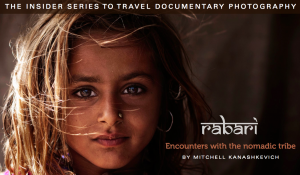If you read my earlier
post about my photography library you know I love books about photography. I have books about composition, technical aspects, printing, Lightroom, HDR, and many others. Recently I've been buying electronic eBooks. These books are typically not printed in hard copy format but are books in Adobe Acrobat (PDF) format that can be read on a PC, MAC, iPAD, or Smart Phone. It makes taking your library along with you on a photo outing much easier. Because there is no printing or distribution costs these eBooks are typically cheaper than hard copy books. Most are also shorter than normal books. I'm really not sure why.

This week I got a copy of
Rabari - Encounters With the Nomadic Tribe by Mitchell Kanashkevich. This is part of The Insider Series on Travel Documentary Photography by
LightStalking. The title suggests it is a travel book but it's really a book about photography that just happens to use the author's four month long travels in this region of India for the examples.
Here's the table of contents for the book:
After a brief introduction to the project, the equipment (surprisingly affordable) and the work flow, the author goes into details about each of 10 different photos from the project. For each photo, he discusses background information, objectives for that particular photo, the light, the moment and/or pose, the composition, the "Biggest Challenge" and how me managed it, and the what/why of post processing.
The author provides great insight into what was going through his mind when he was working on that particular photo. Reading these well written descriptions is like being with him on the photo shoot and having him tell you what he's doing and why.
One thing I was surprised to learn was how little equipment he used. He didn't have high end cameras, lenses, or elaborate artificial lights. Instead he relied on a 5-in-one reflector for his lighting. He describes the conditions he was shooting in and includes diagrams showing where the subject, light source and camera were located.
I found his description of the biggest challenge with each situation and how he overcame it to be instructive. While I may never run into that exact challenge, his approach to solving the problems was educational as I learned things I will be able to apply later.
He uses a combination of Adobe Lightroom and Adobe Photoshop to edit his photos. In the book he talks about what adjustments he made to the photo and how he made the adjustments. The book is more about the photography and is less about post-processing. He includes before and after versions of the photo.
Reading this book was entertaining and informative. The photos reached out and grabbed me right off. You can see why Mitchell Kanashkevic is a successful travel and documentary photographer. I recommend this book for amateurs as well as professional photographers.
Rabari – Encounters With the Nomadic Tribe is available for download for the
special Christmas release price of $19.95 when you apply the special launch discount code “
HAPPYXMAS” until Dec 25th.
Go online and buy a copy. There's no waiting for shipment so you can start reading right away.


























